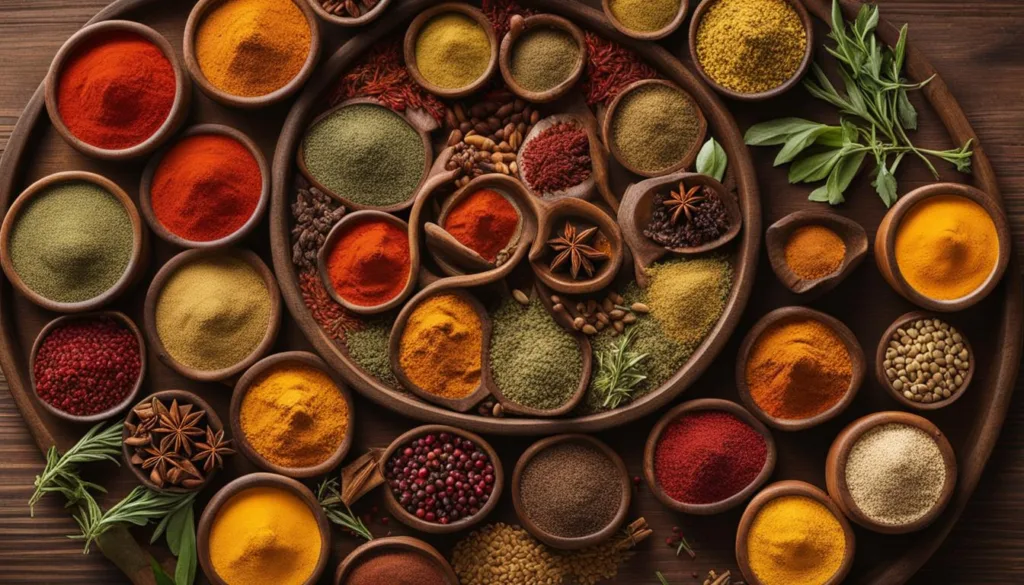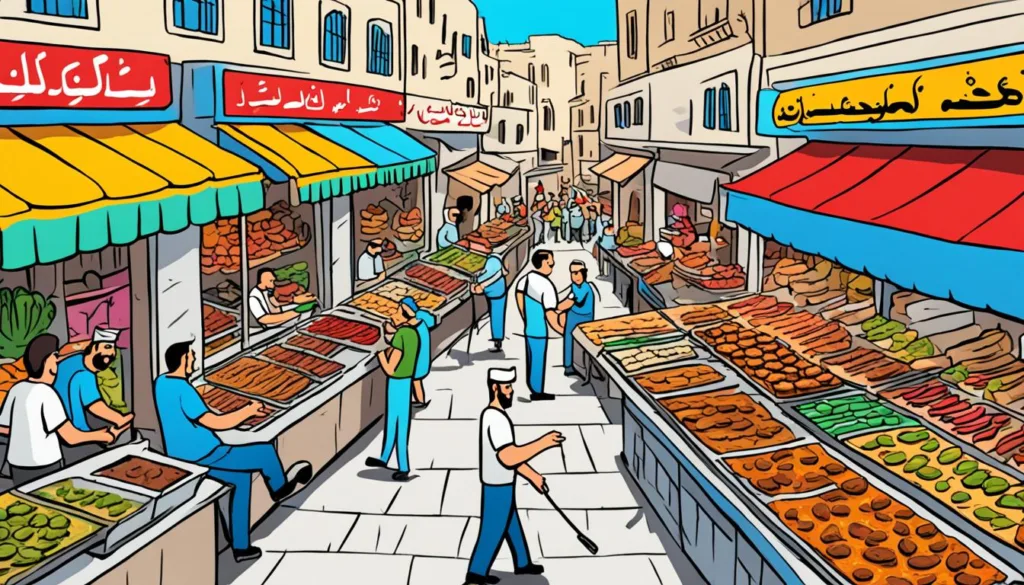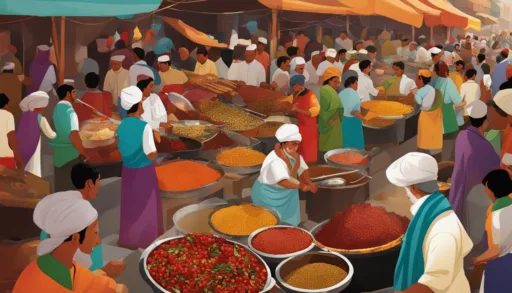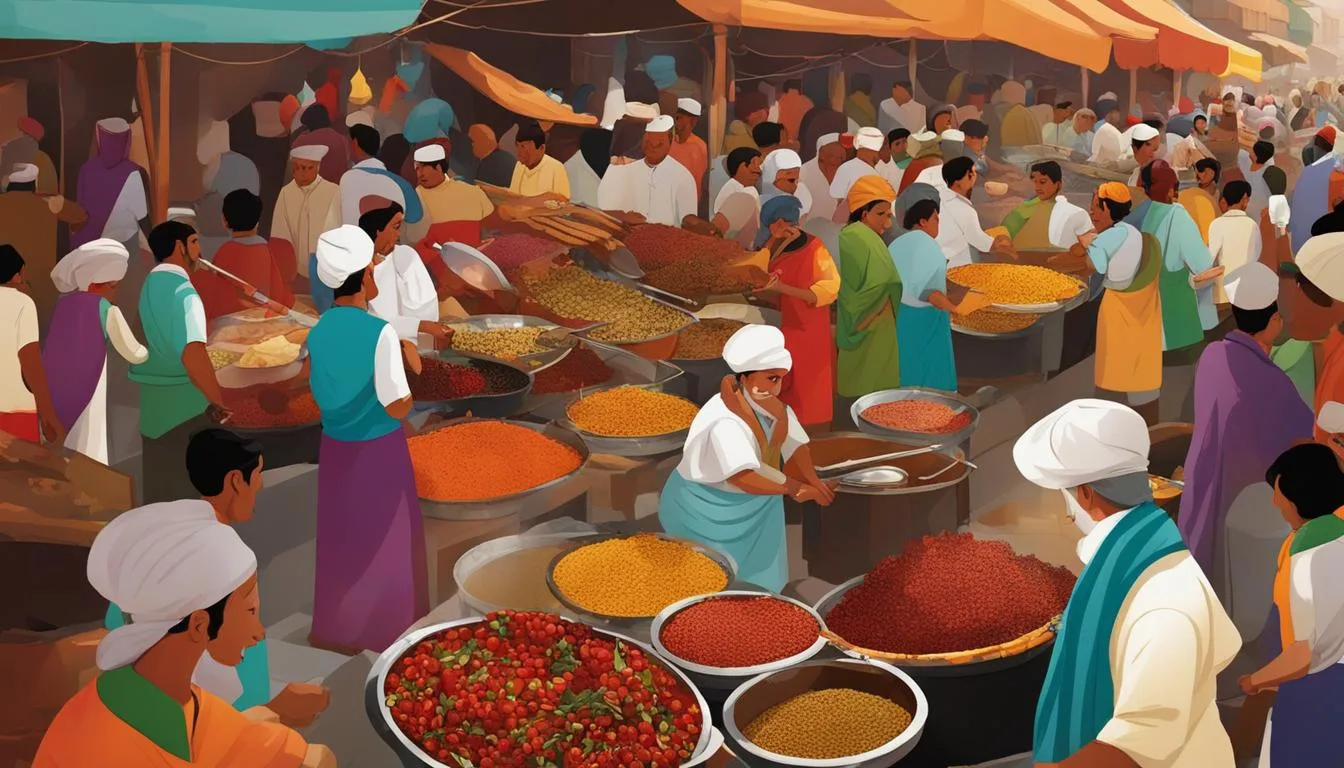When was the last time a dish transported you through time, to the heart of ancient civilizations? Embark on a culinary expedition that uncovers the secrets of a cuisine that has marinated in history’s pot. Our Syrian Cuisine Guide offers you more than just a menu; it’s a parchment of recipes steeped in the legacy of empires. This isn’t just about savoring Authentic Syrian dishes, it’s about relishing the stories that forged one of the richest Middle Eastern cuisines. With each bite into Syria’s gastronomy, you’re biting into an epic tale of convergence, crafting a culture that celebrates the fragrance of the past. Ready your palate for a journey through the bustling streets of Damascus, through the traditions and homes that have preserved the heart of Syrian food culture. Tickle your taste buds with age-old Traditional Syrian cooking and savor the dishes that tell the story of a nation rich in flavor and steeped in heritage.
Key Takeaways
- Discover the historical influences that have shaped Syrian cuisine into a culinary mosaic.
- Uncover the role of key ingredients and spices in crafting the hallmark flavors of Authentic Syrian dishes.
- Explore the diversity within Syrian food culture and how it reflects the nation’s rich tapestry of traditions.
- Learn why Traditional Syrian cooking goes beyond taste, offering a sociable experience tied to community and family.
- Realize the impact that the geographical and cultural crossroads of Syria have on its cuisine, introducing a variety into Middle Eastern cuisine.
- Understand how local culinary customs reflect the Syrian way of life and the importance of shared meals.
The Tapestry of Syrian Flavors: An Introduction
At the heart of the Middle East lies Syria, a country that serves as a culinary crossroads where the flavors of the Mediterranean and Arab worlds enticingly converge. Syrian cuisine is a historical melting pot, drawing from both its ancestral heritage and the rich blend of cultures that have traversed its land. Over time, authentic Syrian dishes have evolved to become a gastronomic lexicon of taste and tradition.
Essential to the fabric of Syrian culinary traditions are the key ingredients that deliver the distinctive flavors known worldwide. The likes of olive oil, bulgur, and lamb are staples, finding their way into an array of recipes and underpinning the texture and taste of Syrian gastronomy. No Syrian feast is complete without an array of spices such as cumin, garlic, sumac, and the renowned Aleppo pepper. These spices are more than just seasonings; they are a narrative of Syrian history told through cuisine.
- Kibbeh – A beloved classic, kibbeh is an exemplary Syrian recipe that showcases the national love for textures and flavors. Ground lamb, cracked wheat, and a mélange of spices come together to form this quintessential dish.
- Hummus – This smooth, creamy concoction made from chickpeas and tahini is a testament to the Syrian knack for transforming simple ingredients into global staples.
- Shawarma – Succulent slices of marinated meat rotating on a spit are a sight to behold and a marvel to taste, epitomizing the vibrant Syrian street food scene.
The social fabric of Syrian food culture is woven with threads of hospitality and the joy of sharing. Families and friends gather over meals not just to eat, but to forge bonds and create memories. In this sense, Syrian recipes are far more than instructions for preparing meals; they represent an inherent sense of community and the enduring spirit of Syrian generosity.
Witnessing the harmonized dance of ingredients and traditions that form authentic Syrian dishes leaves an indelible mark on the palate of those fortunate enough to experience this rich and diversified cuisine. Syria’s culinary contributions to the world are not merely dishes but gifts of heritage and history that continue to bring people together across continents.
Syrian Cuisine Guide: Essential Ingredients and Spices
In the heart of the Middle East, Syrian cuisine presents a palette of flavors that are as rich as the country’s history. The very essence of Traditional Syrian cooking lies within its use of celebrated staples. Each ingredient carries a story, infusing dishes with not just taste but also with historical significance. Let us delve into the core components that make Syrian food culture both unique and inviting.
Olive Oil: The Liquid Gold of Syria
Olive oil is revered in Syrian cuisine, an elixir that has graced Mediterranean diets for millennia. It is generously drizzled over fresh salads, used as a cooking base for stews and meats, and even added to dips and spreads to enhance their flavor and texture. The importance of olive oil in Syrian culinary practices cannot be overstated; it’s a testament to the region’s agricultural prosperity and a vital element of nourishment.
Lamb: The Centerpiece of Many Syrian Recipes
The mention of lamb stirs the thoughts of succulent and aromatic dishes that have long been favorites in Syrian households. Essential ingredients in Syrian cuisine, such as lamb, often feature in celebratory dishes or as the main course in the daily family meal, demonstrating its undeniable prominence in the culinary landscape.
Bulgur and Aromatic Spices: Foundations of Flavor
Bulgur, a kind of dried cracked wheat, is a staple grain that anchors the foundation of numerous traditional dishes, including the iconic tabbouleh and pilafs. It is harmoniously paired with a symphony of spices such as cumin, sumac, and the distinctive Aleppo pepper—each adding a layer of complexity and zest to Syrian recipes.

To fully appreciate the aromatic spices and key ingredients that are the hallmarks of this cuisine, let’s explore a table that succinctly captures their essence and common uses:
| Ingredient | Common Use | Notes |
|---|---|---|
| Olive Oil | Dressings, Cooking, Dips | Extra-virgin olive oil is preferred for its flavor and health benefits. |
| Lamb | Kibbeh, Shawarma, Stews | Often ground or slow-cooked to tenderness, it’s a protein-rich centerpiece. |
| Bulgur | Tabbouleh, Pilafs, Kibbeh | A versatile grain that’s high in fiber and pairs well with spices. |
| Cumin | Meat Rubs, Stews, Soups | Provides a warm, earthy note that’s essential to many blends. |
| Garlic | Marinades, Dips, Sauces | A universal seasoning that enhances savory aspects of a dish. |
| Sumac | Salads, Meats, Dressings | Offers a tangy, lemony flavor without the acidity of citrus. |
| Aleppo Pepper | Seasoning Blend, Kebabs, Dips | Mildly hot with a fruity undertone, named after the city of Aleppo. |
The symphony of flavors embodied within these ingredients is what elevates Syrian dishes, offering a sensory journey to anyone willing to explore the art of Traditional Syrian cooking. As overseers of an esteemed culinary heritage, Syrian cooks continue to honor their legacy with every dish that graces the family table.
Signature Dishes of Syria: From Mezze to Mains
The culinary landscape of Syria is as diverse as it is flavorful, encompassing an array of dishes that have been honed over centuries of tradition. The country’s gastronomic offering ranges from the shared pleasures of mezze to hearty main courses, each telling its own story of cultural history and culinary expertise. To truly understand the heart of Syrian cuisine, one must delve into the quintessential dishes that have shaped the nation’s food culture.
For starters, a mezze spread is more than just an appetizer; it’s a social experience. These small plates are a glimpse into the generosity of Syrian hospitality, featuring classics such as hummus, baba ganoush, tabbouleh, and falafel. They set the stage for what’s to come, as each bite-sized portion bursts with the fresh, vibrant flavors of Traditional Syrian cooking.
Moving on to main courses, Syrian recipes offer robust options like the hearty stews that simmered to perfection and the savory pastries such as fatayer, which are often stuffed with spinach, meat, or cheese. Rice dishes, like the succulent roz bil djej (chicken with rice), are expertly seasoned with a blend of spices that are the hallmark of Authentic Syrian dishes.
Among Syria’s most iconic culinary exports is kibbeh — a testament to the mastery of Syrian recipes and a point of pride within the country’s cuisine. Best Syrian restaurants serve this dish in various forms, from fried croquettes to raw preparations, each bursting with flavor and encased in a crisp bulgur wheat shell.
To experience the full breadth of Syrian cuisine, it is crucial to embark on a taste adventure through the Best Syrian restaurants. There, the kaleidoscope of flavors and the ancestral culinary techniques come to life, leaving a lasting impression on anyone who samples these Authentic Syrian dishes.
- Hummus: A creamy blend of chickpeas, tahini, lemon, and garlic
- Baba Ganoush: A smoky, tangy eggplant dip enriched with tahini and spices
- Tabbouleh: A fresh herb salad with bulgur, tomato, and lemon dressing
- Falafel: Crisp, deep-fried chickpea patties spiced with cumin and coriander
- Stews: Slow-cooked to develop deep, rich flavors inherent in Syrian stews
- Fatayer: Savory pastries filled with a variety of spiced mixtures
- Roz Bil Djej: Fragrant rice cooked with chicken, nuts, and a bouquet of spices
- Kibbeh: A signature dish with minced meat and bulgur, often considered the national dish of Syria
In conclusion, the journey through Syrian cuisine is one rife with history, culture, and undeniable taste. Whether you’re enjoying the conviviality of mezze or the satisfaction of a main course, Syrian dishes offer a culinary odyssey unlike any other.
The Art of Syrian Street Food
The bustling streets of Syria are a mosaic of scents and flavors, where traditional Syrian cooking meets the hands of skilled street food vendors. The vibrant scenes at the markets and alleys showcase a rich part of Syrian culinary traditions, offering a tapestry of taste experiences to locals and travelers alike. Among the grandeur of Syrian street food, certain dishes stand out for their popularity and play a crucial role in epitomizing the food culture of this region.

The Irresistible Charm of Shawarma
One cannot speak of Syrian street food without lauding the ever-popular shawarma. This mouthwatering dish is a symphony of thinly sliced meat marinated in aromatic spices, then stacked and roasted on a slowly-turning vertical spit. The meat is shaved off in tender strips, enveloped within a warm blanket of flatbread, and often dressed with garlic sauce, pickles, fries, and fresh vegetables. Shawarma isn’t just food; it’s a cultural icon found in the best Syrian restaurants and street-side stalls.
Falafel and Hummus: A Duo for the Ages
Falafel, the golden-brown balls of spiced chickpeas, consider early mornings their domain, as the aroma of freshly fried goodness lures patrons from every corner. Paired often with hummus, a creamy dip made from chickpeas, tahini, olive oil, lemon juice, and garlic, these two form a duo that resonates with the essence of Syrian street food. Falafel, often served in pitas or on its own with dips, offers a versatile option for vegans and vegetarians, while hummus works its way into the hearts of all who taste it. Whether enjoyed as a quick snack or a meal, this duo is foundational to the Syrian street food experience.
| Street Food Item | Key Ingredients | Typical Serving |
|---|---|---|
| Shawarma | Marinated meat, garlic sauce, vegetables | Wrapped in flatbread |
| Falafel | Chickpeas, herbs, spices | Pita sandwiches or with dips |
| Hummus | Chickpeas, tahini, olive oil, lemon juice, garlic | Dip for bread or veggies |
In conclusion, the streets of Syria provide a canvas for the rich tableau of flavor intrinsic to Middle Eastern cuisine. To partake in a meal at a street vendor’s stall is to engage with the history and innovation inherent in Syrian culinary traditions. From the seasoned meats of shawarma to the comforting blend of falafel and hummus, Syrian street food is an art form that continues to invite and enchant with each bite.
Dining Like a Local: Best Syrian Restaurant Experiences
When the rich aromas of Authentic Syrian dishes beckon, immerse yourself in the heart of Syrian food culture by dining at the best Syrian restaurants. It’s not just about relishing the flavors; it’s about being part of an experience steeped in Traditional Syrian cooking and the joy of breaking bread together.

Syrian eateries ranging from local favorites to fine-dining establishments all share one thing in common: an unwavering emphasis on hospitality. Whether you are indulging in a lavish spread of mezze or enjoying the humble perfection of street-style falafel, the ambiance of communal dining is palpable.
- Begin with a mezze platter laden with hummus, muhammara, and labneh, each dish a testament to the rich culinary tapestry of Syria.
- Move on to the classics: succulent lamb kebabs, perfectly spiced and grilled, embodying the essence of the Syrian palate.
- End with a traditional dessert, perhaps a serving of baklava or boozy ice cream, signifying an end to a meal but the continuation of conversation and culture.
These unforgettable dining scenarios serve as a vibrant entry point into the wonderfully complex and community-centric world of Syrian cuisine. Whether a local or a visitor, the experience is designed to make everyone feel at home.
Exploring the Regions: Damascus Cuisine Versus Aleppo Flavors
The rich tapestry of flavors in Syrian cooking reflects the country’s diverse cultural heritage and regional nuances. Damascus cuisine embodies the heart of Syria’s food culture with its unique combination of sweet and savory elements, while Aleppo stands as a beacon of traditional gastronomy, offering bold and sophisticated flavors that have evolved over centuries of trade and cultural exchanges.
Damascus Delights: A Blend of Sweet and Savory
Damascus, often hailed as the oldest continuously inhabited city in the world, has long been a melting pot of civilizations, each bringing their culinary contributions. The city’s cuisine is characterized by a blend of sweet fruits and rich meats, often complemented by a dash of subtle spices to deliver a warm and comforting food profile.
Aleppo’s Gastronomy: Bold and Sophisticated
Aleppo’s gastronomy is a testament to the city’s history as a silk road trading center. This crossroads of spices, flavors, and cooking techniques from Asia, Europe, and the Middle East results in a bold and sophisticated culinary tradition within Syrian cooking. Aleppo’s contribution to Regional Syrian cooking is evident in its love for spice, herb, and nut-infused dishes, reflecting the city’s rich and opulent history.
Comparing the culinary traditions of these two vibrant cities highlights the diversity and the rich tapestry that Syrian cuisine offers. Below is a table showcasing some signature dishes from Damascus and Aleppo:
| Damascus Cuisine | Aleppo Flavors |
|---|---|
| Fattoush Salad | Muhammara Dip |
| Makdous (Stuffed Eggplants) | Kebab Halabi |
| Bamieh (Okra Stew) | Cherry Kebab |
| Syrian Stuffed Zucchini | Aleppo Pepper Kebabs |
Whether indulging in the sweet-and-savory harmony of Damascus cuisine, or embracing the rich, spice-filled Aleppo flavors, one’s palate is sure to embark on an extraordinary journey through the diverse landscape of Regional Syrian cooking.
The Syrian Culinary Experience: Traditional Cooking Techniques
Delving into traditional Syrian cooking is to discover a world where time-honored techniques and the freshest ingredients interweave to create dishes with deep-rooted flavors. Syrian cuisine’s rich tapestry is painted with broad strokes of culinary mastery and a palette of vibrant spices. Let’s explore the time-tested methods that define this storied gastronomic tradition and offer listeners valuable Syrian cooking tips.
The hallmark of Syrian cuisine lies in its ability to layer flavors through meticulous spice blends and slow-cooking methods. A Syrian kitchen is a place where the complexity of flavors comes to life, benefiting from patient simmering that enhances the depth of every dish. Grounded in the heritage of the Levant, Syrian culinary traditions regard cooking as an art in progress, constantly perfecting and preserving ancestral wisdom.
| Technique | Application in Syrian Cooking | Culinary Tips |
|---|---|---|
| Slow Cooking | Used for stews and legumes to achieve tender, flavorful results. | Simmer at low temperatures for several hours to enhance the richness of flavors. |
| Grilling | Adopted for meats and vegetables to impart a smoky taste and crisp texture. | Use moderate heat and occasionally turn the food for even grilling. |
| Stuffing | Integral for dolmas and kibbeh, combining various ingredients in one bite. | Maintain the balance of flavors and don’t over-stuff to ensure even cooking. |
| Marinating | Essential for meats and vegetables, imbuing them with robust flavors. | Marinate with a mix of spices and let it rest for several hours, preferably overnight. |
| Baking | Applied to pastries and bread, serving as a staple in Syrian homes. | Monitor oven temperatures and time for perfectly baked goods with a golden hue. |
Adhering to these techniques not only honors the legacy of Syrian cooks but also brings an element of cultural narrative to the dining table. Aspiring cooks around the world can enrich their craft by adopting these authentic practices from Syrian culinary traditions. To master the art of Syrian cuisine, keep in mind that patience and precision are your best allies.
- For the ideal Syrian flavor, season with a generous hand and an open heart.
- To evoke the quintessence of Syria, opt for time-honored recipes and fresh, locally-sourced ingredients.
- And remember, the Syrian hearth is a place where stories, not just meals, are made.
As you incorporate these Syrian cooking tips, each dish you prepare becomes a step closer to the soulful meals savored in the bustling alleys of Damascus or the seasoned kitchens of Aleppo. Embrace the process and relish the journey that each meal represents, for it is in the cooking that we touch the heartbeat of Syrian culture.
Syrian Sweets: A Journey Through Desserts and Pastries
Embark on a delightful exploration of Syrian desserts, where the art of pastry and the love of sugared confections intertwine. As a cornerstone of Middle Eastern cuisine, these desserts boast intricate designs and complex flavors, epitomizing traditional Syrian cooking at its sweetest.
Baklava and Beyond: Honeyed Treats
Syrians take pride in their baklava, a layered phyllo pastry dessert that tempts the palate with its sweet nutty fillings and aromatic honey drizzle. However, the Syrian confectionery repertoire extends far beyond baklava, boasting a rich tapestry of honeyed treats that add sweetness to every special occasion.
Knafeh: The Sweet Synergy of Cheese and Dough
Knafeh manifests the perfect balance of melt-in-your-mouth cheese and crispy dough, drenched in a fragrant sweet syrup. This delectable dessert is a testament to the creativity and culinary excellence that Syrian sweets are celebrated for.
| Dessert | Main Ingredients | Origin Story | Occasions |
|---|---|---|---|
| Baklava | Phyllo dough, nuts, honey or syrup | Byzantine empire, perfected in the Middle East | Eid celebrations, weddings |
| Knafeh | Cheese, semolina dough, sweet syrup | A love affair between cheese and dough that originated in the Levant | Ramadan, social gatherings |
The Importance of Hospitality and Communal Meals in Syrian Culture
In the heart of the Middle Eastern cuisine, Syrian food culture is an intricate tapestry woven with the threads of hospitality and communal sharing. The very essence of Syrian culinary traditions is rooted in the generous spirit of its people – where the dining table becomes a place of union, not just for families, but for entire communities. Reflecting the Syrian gastronomy’s cherished principle, communal meals are designed to bring individuals closer, fortifying bonds and creating an atmosphere of genuine warmth and shared pleasure. It is a cultural bridge that turns strangers into friends, amidst the aromatic spreads of spices and flavors.
This cultural hallmark is significantly embodied in Syrian culinary customs like the mezze platter, which is much more than an assortment of dishes. It’s an invitation to engage, share and sample a variety of delicacies together. The extended dinner courses that follow are not merely about satiating hunger but are a celebration of life’s moments, big and small. In Syria, the act of breaking bread transcends the physical nourishment, nurturing the soul and the community as a whole. This is the Syrian way, where every meal is an opportunity to reaffirm social ties and to honor the age-old adage that sharing truly is caring.
The approach to meals within Syrian communities signifies more than just culinary preference – it’s the embodiment of their heritage and identity, a ritual that preserves their legacy through each simmering pot and shared plate. The magnanimity the Syrian people exhibit through their cuisine is not just an act of feeding, it’s extending a piece of their home and their heart. When you partake in a Syrian feast, you’re not merely savoring the eclectic flavors of Middle Eastern cuisine, you are part of a communal experience that ceases to distinguish between guest and family.






